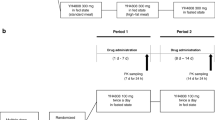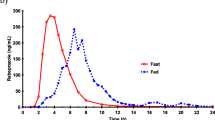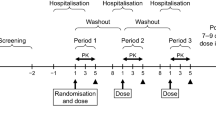Abstract
Objective: To investigate the effect of food on the pharmacokinetics of eslicarbazepine acetate (BIA 2-093), a new voltage-gated sodium channel antagonist.
Material and methods: Single-centre, open-label, randomised, two-way crossover study in 12 healthy subjects. The study consisted of two consecutive treatment periods separated by a washout of 14 days or more. In each of the study periods subjects were administered a single dose of eslicarbazepine acetate 800mg following either a standard high-fat content meal or 10 hours of fasting.
Results: Eslicarbazepine acetate was rapidly and extensively metabolised to BIA 2-005. Maximum BIA 2-005 plasma concentrations (Cmax) in fed (test) and fasting (reference) conditions were, respectively, 12.8 ± 1.8 μg/mL and 11.3 ± 1.9 μg/mL, and the areas under the plasma concentration time curve from 0 to infinity (AUC∞) were, respectively, 242.5 ± 32.1 μg · h/mL and 243.6 ± 31.1 μg · h/mL (arithmetic mean ± SD). The point estimate (PE) and 90% confidence interval (90% CI) of the test/reference Cmax geometric mean ratio were 1.14 and 1.04, 1.25, respectively; for the AUC∞ ratio, the PE and 90% CI were 1.00 and 0.95, 1.04, respectively. Bioavailability of eslicarbazepine acetate administered in fed and fasting conditions was similar and bioequivalence is accepted for both AUC∞ and Cmax because the 90% CI lies within the acceptance range of 0.80–1.25. No statistically significant differences were found in time of occurrence of Cmax.
Conclusion: The presence of food had no significant effect on the pharmacokinetics of eslicarbazepine acetate and therefore this new voltage-gated sodium channel antagonist may be administered without regard to meals.



Similar content being viewed by others
References
Bonifacio MJ, Sheridan RD, Parada A, et al. Interaction of the novel anticonvulsant, BIA 2-093, with voltage-gated sodium channels: comparison with carbamazepine. Epilepsia 2001; 42: 600–8
Benes J, Parada A, Figueiredo AA, et al. Anticonvulsant and sodium channel-blocking properties of novel 10,11-dihydro-5H-dibenz[b,f]azepine-5-carboxamide derivatives. J Med Chem 1999; 42: 2582–7
Silveira P, Falcão A, Almeida L, et al. BIA 2-093 pharmacokinetics in healthy elderly subjects [abstract]. Epilepsia 2004; 45 Suppl. 3: 157
Almeida L, Soares-da-Silva P. Safety, tolerability and pharmacokinetic profile of BIA 2-093, a novel putative anti-epileptic agent, during first administration to humans. Drugs R D 2003; 4 (5): 269–84
Almeida L, Soares-da-Silva P. Safety, tolerability, and pharmacokinetic profile of BIA 2-093, a novel putative antiepileptic, in a rising multiple-dose study in healthy humans. J Clin Pharmacol 2004; 44: 906–18
Maia J, Almeida L, Soares-da-Silva P. BIA 2-093 as add-on therapy for refractory partial epilepsy in adults [abstract]. Epilepsia 2004; 45 Suppl. 3: 158
Guidance for Industry (Draft). Food-effect bioavailability and fed bioequivalence studies: study design, data analysis, and labeling. Rockville, MD: US Department of Health and Human Services, Food and Drug Administration Center for Drug Evaluation and Research (CDER), 2001 Oct
Schuirmann DJ. A comparison of two one-sided tests procedure and the power approach for assessing the equivalence of average bioavailability. J Pharmacokinet Biopharm 1987; 15 (6): 657–80
Guidance for Industry (Draft). Bioavailability and bioequivalence studies for orally administered products: general considerations. Rockville, MD: US Department of Health and Human Services, Food and Drug Administration Center for Drug Evaluation and Research (CDER), 2002 Jul
Note for guidance on the investigation of bioavailability and bioequivalence. London: European Agency for the Evaluation of Medicinal Products, Committee for Proprietary Medicinal Products, CPMP/EWP/QWP/1401/98, 2001 Jul 26
Acknowledgements
This work was financially supported by BIAL S.A.
Author information
Authors and Affiliations
Corresponding author
Rights and permissions
About this article
Cite this article
Maia, J., Vaz-da-Silva, M., Almeida, L. et al. Effect of Food on the Pharmacokinetic Profile of Eslicarbazepine Acetate (BIA 2-093). Drugs R D 6, 201–206 (2005). https://doi.org/10.2165/00126839-200506040-00002
Published:
Issue Date:
DOI: https://doi.org/10.2165/00126839-200506040-00002




